Embarking on a canoe journey is not just about paddling through the water; it’s an adventure that tests your endurance, skill, and connection with nature. But one question often arises for enthusiasts and beginners alike: “How long does it take to canoe 6 miles?” This question might seem straightforward, yet the answer is influenced by a myriad of factors. Dive into this discussion to uncover the variables that determine the duration of your canoeing expedition and how you can efficiently navigate through them.
Factors Affecting Canoeing Speed
Several variables influence how swiftly a canoe can cover a distance, such as 6 miles. These factors include the paddler’s strength and experience, the canoe’s design, and environmental conditions. The paddler’s skill level is paramount, as efficient stroke techniques can significantly increase speed. Additionally, the type of canoe plays a crucial role; for instance, sleek, lightweight models are faster than wider, heavier ones. Environmental elements such as wind, current, and water type also have a substantial impact. Calm, clear waters allow for quicker progress than battling against a strong current or navigating choppy conditions. Understanding these factors helps in estimating the time it might take to canoe a specific distance.
Weather conditions cannot be overlooked. A strong headwind can slow progress, while a tailwind can aid in moving faster. Water currents, if against the direction of travel, can significantly increase the effort required to paddle 6 miles. Conversely, a favorable current can reduce the time and energy needed. Lastly, the canoe’s load, including the weight of paddlers and any gear, affects the speed. A heavily loaded canoe will travel slower compared to one that’s lightly loaded.
Further Context on Canoeing Speed
Exploring deeper into the elements affecting canoeing speed, it’s vital to consider the paddler’s endurance and the journey’s duration. Longer trips require consistent pacing to avoid fatigue, which can decrease speed over time. The synergy between paddlers, if canoeing in tandem, also influences the overall velocity. Coordination and rhythm in strokes can lead to a more efficient journey, reducing the time taken to cover 6 miles.
Additional Insights into Canoeing Dynamics
Considering the canoe’s design, aspects such as hull shape and material composition further define its speed capabilities. Slimmer canoes with pointed bows are designed for speed and efficiency in cutting through water, whereas wider hulls offer stability but at the cost of increased drag. The choice of paddle, from its length to blade shape, also contributes to the canoe’s speed, emphasizing the importance of selecting equipment that aligns with the paddler’s strength and technique.
| Factor | Impact on Speed | Possible Effect |
|---|---|---|
| Paddler’s Skill | High | Increases with technique |
| Canoe Design | High | Sleeker is faster |
| Environmental Conditions | Variable | Can both increase and decrease |
| Load | Medium | Heavier is slower |
| Weather | Variable | Wind and current can aid or hinder |
Understanding the Time it Takes to Canoe 6 Miles
The time it takes to canoe 6 miles can vary widely based on a number of factors including the paddler’s experience, water conditions, and the type of canoe used. On average, a person can canoe at a speed of about 2 to 4 miles per hour on calm water. Therefore, under ideal conditions, canoeing 6 miles would take approximately 1.5 to 3 hours. However, this is a simplified estimate.
For beginners, the journey might take longer due to less efficient paddling techniques. Conversely, experienced paddlers who can maintain a steady pace and navigate effectively may complete the distance in a shorter time frame. Water currents and wind can also play a significant role. Paddling downstream with the current on your side will significantly reduce your time, whereas paddling upstream or against strong winds can increase it.
It’s important to consider breaks and rest periods, especially on longer trips. Fatigue can set in, reducing your paddling efficiency and overall speed. Planning for rest can make the journey more enjoyable and sustainable, especially if you’re not in a rush. Remember, canoeing is not just about reaching your destination but also enjoying the journey and the natural beauty around you.
Factors Influencing Canoeing Time
| Factor | Impact on Canoeing Time | Example |
|---|---|---|
| Experience Level | More experienced paddlers can canoe faster and more efficiently. | Experienced paddler vs. Beginner |
| Water Conditions | Smooth, calm waters are faster to canoe in than choppy, turbulent waters. | Calm lake vs. Choppy river |
| Weather | Wind and rain can slow down progress significantly. | Headwind vs. Tailwind |
| Type of Canoe | Some canoes are designed for speed, while others are for stability and leisure. | Racing canoe vs. Recreational canoe |
| Rest Breaks | Taking breaks can prolong the overall time but is essential for longer distances. | Continuous paddling vs. Taking breaks |
Maximizing Efficiency in Canoeing
Understanding the factors that influence canoeing time is crucial for planning your trip. Whether you’re paddling for leisure or training, focusing on improving your paddling technique, choosing the right equipment, and being mindful of weather and water conditions can enhance your efficiency on the water. Remember, every paddler’s experience is unique, and the joy of canoeing comes as much from the journey as it does from the physical activity.
Average Canoeing Speeds
Understanding average canoeing speeds is crucial for planning your paddling adventures, especially if you’re considering a trip that covers a specific distance, such as 6 miles. The speed at which a canoe moves through the water is influenced by various factors, including the paddler’s skill level, the type of canoe, water conditions, and whether the journey involves carrying additional weight, such as camping gear or supplies.
For most recreational canoeists, the average paddling speed hovers around 2 to 3 miles per hour under normal conditions. This pace assumes a steady, moderate effort without pushing too hard, which is sustainable over a longer period. However, experienced paddlers in sleek, streamlined canoes can achieve speeds of up to 4 to 6 miles per hour, especially if they are paddling in favorable conditions with little to no wind resistance and a calm current. Conversely, navigating against strong currents, winds, or in heavier, less efficient canoes can significantly reduce your average speed, sometimes down to 1 mile per hour or less.
It’s also important to note that endurance plays a role in maintaining a consistent speed over distances like 6 miles. Paddlers must pace themselves to avoid exhaustion, especially if the journey includes portages or challenging navigational elements. The use of tandem canoes can also affect speed, often allowing for higher speeds due to the combined power of two paddlers, assuming both are in sync and contributing equally to the effort.
When planning a canoe trip, consider these factors carefully. Estimate your travel time based on a realistic assessment of your abilities and the conditions you expect to face. Remember, the journey’s enjoyment isn’t just about speed but also about experiencing the beauty and tranquility of the waterways.
- Assess your skill level and the condition of your canoe before setting out.
- Consider the water conditions, including current strength and wind presence.
- Factor in any additional weight you’ll be carrying in the canoe.
- Plan for breaks and rest periods, especially on longer trips.
- Practice steady, efficient paddling techniques to maintain a consistent speed.
When it comes to canoeing, the average speeds mentioned provide a general guideline. However, every paddling experience is unique, influenced by a myriad of factors from the paddler’s technique to environmental conditions. By understanding these aspects and preparing accordingly, canoeists can ensure a rewarding and successful journey, regardless of the distance covered.
Paddling Techniques and Efficiency
The time it takes to canoe 6 miles can greatly vary depending on several factors, with paddling techniques and efficiency being among the most significant. A well-honed paddling technique can not only increase the distance covered in a single stroke but also reduce the paddler’s fatigue, enabling a more enjoyable and faster journey. It is crucial to understand that effective paddling goes beyond mere physical strength; it involves a synergy of rhythm, power, and stroke precision.
One fundamental aspect of efficient paddling is the catch phase, where the paddle blade is planted in the water. This should be done with minimal splash and maximum control, ensuring that each stroke is as powerful as possible. Following the catch, the power phase of the stroke propels the canoe forward. This requires not just arm strength, but a coordinated effort that engages the paddler’s core and legs, offering a fuller range of motion and optimized power. Finally, the release and recovery phase should be smooth, setting up for the next stroke with minimal drag.
Another vital component for efficiency is maintaining a steady rhythm. A consistent stroke rate helps in keeping the canoe on a straight course, reducing the need for corrective strokes that slow progress. Combining these techniques with a keen awareness of the water conditions and effective use of the canoe’s features can significantly impact the paddling efficiency, allowing for quicker completion of a 6-mile journey.
| Technique | Impact on Efficiency | Recommended Practice |
|---|---|---|
| Catch Phase | Improves initial stroke power | Focus on smooth entry with minimal splash |
| Power Phase | Maximizes propulsion | Engage core and legs, not just arms |
| Stroke Rhythm | Keeps the canoe on a straight course | Maintain a consistent stroke rate |
| Release and Recovery | Prepares for the next stroke efficiently | Smooth transition with minimal drag |
| Canoe Features | Leverages design for speed and stability | Understand and utilize design advantages |
In addition to mastering paddling techniques, it’s equally important to understand how these methods translate into long-distance efficiency. Paddlers should aim to balance their energy expenditure across the journey, conserving strength for sustained effort rather than short bursts of speed. This approach, combined with the strategic technique application, can significantly reduce the time it takes to cover 6 miles in a canoe. Regular practice and mindful adjustments based on water conditions and fatigue levels will further enhance paddling efficiency, making for a swift and enjoyable trip.
Environmental Conditions Impact
The time it takes to canoe 6 miles can vary significantly based on a range of environmental conditions. These conditions can either act as a catalyst that speeds up your journey or as a barrier that slows you down. Understanding the impact of each condition is crucial for accurate planning and preparation for your canoeing adventure.
Firstly, the type of water body you are navigating plays a significant role. Canoeing down a river with a steady current can significantly reduce the time it takes to cover 6 miles compared to paddling on a still lake where you rely entirely on your own strength and endurance. Additionally, the water current’s direction is pivotal; paddling upstream is considerably more challenging and time-consuming than moving with the current.
Weather conditions are another critical factor. Wind speed and direction can greatly influence your paddling effort and speed. A strong headwind can make paddling feel like you’re moving through molasses, drastically increasing the time and energy needed to reach your destination. Conversely, a tailwind can propel you forward, reducing the time it takes to cover the distance. Moreover, extreme weather conditions such as storms or heavy rain can not only delay your progress but also pose significant safety risks.
Finally, the condition of your equipment and your preparedness for the journey cannot be overlooked. A well-maintained canoe, appropriate paddling gear, and a solid understanding of canoeing techniques can mitigate some of the negative impacts of challenging environmental conditions. Conversely, inadequate preparation can amplify the difficulties posed by these conditions.
- Type of water body (river, lake, etc.)
- Water current’s direction and speed
- Wind speed and direction
- Weather conditions (rain, storms, etc.)
- Condition and suitability of equipment
In conclusion, environmental conditions have a profound impact on the duration it takes to canoe 6 miles. Canoeists should carefully consider these factors and plan accordingly to ensure a safe and enjoyable trip. It’s not just about paddling; it’s about smart navigation and harmonizing with the elements to make your journey both efficient and memorable.
Canoe Design and Its Influence
The design of a canoe significantly influences its speed, stability, and maneuverability, which are crucial factors when estimating how long it will take to cover a distance of 6 miles. The length and width of a canoe directly impact its performance in the water. Longer canoes tend to glide more efficiently on the water, making them faster and more suitable for covering longer distances. Conversely, wider canoes offer more stability, which might be preferred by beginners or those navigating rougher waters, albeit at the cost of speed.
The hull shape is another critical design aspect that affects a canoe’s capabilities. A flat-bottomed hull offers greater stability on calm waters, making it an excellent choice for fishing or leisure activities. However, it is not the fastest design due to increased drag. V-shaped hulls, on the other hand, cut through water more efficiently and offer better speed, making them ideal for covering the 6 miles more quickly. The material from which a canoe is made – whether it’s lightweight composites like Kevlar or heavier materials like polyethylene – also plays a role in determining its speed and ease of maneuvering.
Further Insights on Canoe Design Impact
Understanding the nuanced impact of canoe design on performance can enhance your paddling experience, ensuring you select a canoe that best matches your intended use, skill level, and the conditions you anticipate encountering. The right design choice can make the journey not only feasible but also enjoyable.
| Design Feature | Impact on Speed | Impact on Stability |
|---|---|---|
| Length | Increases | Varies |
| Width | Decreases | Increases |
| Hull Shape | Varies | Varies based on design |
| Material | Lighter materials increase | Depends on design and build quality |
| Weight | Heavier canoes are slower | Increases with weight |
In conclusion, the design of a canoe profoundly affects its performance, particularly in terms of speed and stability. These factors, in turn, influence how long it will take to canoe 6 miles. By taking into account the length, width, hull shape, and material of the canoe, paddlers can make informed decisions that enhance their paddling experience, ensuring both efficiency and enjoyment on the water.
I’m Adam Reynolds, a dedicated sports writer with a passion for both competitive gaming and betting. In my mid-thirties, I dive deep into the world of sports, providing insightful analyses and strategies to help readers make informed betting decisions. My experience spans various sporting events, where I blend my love for the game with a keen eye for betting trends. Whether I’m dissecting game tactics or offering betting tips, I aim to deliver content that is both engaging and practical. Join me as we explore the exciting intersection of sports and betting together.





